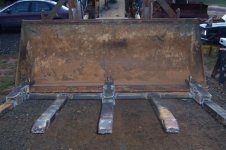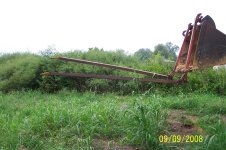AlanB
Elite Member
I built some 8' long fork extensions out of 8" channel iron last weekend.
I need them to move some buildings and roofing and such that is oversize.
I unloaded the roofing yesterday and slightly bent one of the extensions downward.
I was debating if it would be stronger to add vertical rib (s) under the extension, or to plate the entire bottom of the channel and turn it into a tube?
Anyone with some engineering knowledge care to try and explain it or show me a table or some math to figure it out?
TIA
Pictures to follow
I need them to move some buildings and roofing and such that is oversize.
I unloaded the roofing yesterday and slightly bent one of the extensions downward.
I was debating if it would be stronger to add vertical rib (s) under the extension, or to plate the entire bottom of the channel and turn it into a tube?
Anyone with some engineering knowledge care to try and explain it or show me a table or some math to figure it out?
TIA
Pictures to follow






